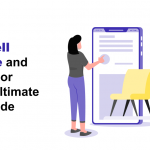How to Optimize Your E-Commerce Store for Mobile Users
- Anurag Pandey
- Last updated on February 7, 2025
- eCommerce, Shopify, Shopify Plus, Woocommerce
- 9 minutes read
Table of Contents
ToggleE-commerce is growing fast, and so are mobile users. With smartphones and tablets becoming more advanced, many shoppers prefer to browse and buy directly from their mobile devices.
But here’s the problem:
If your ecommerce website isn’t mobile-friendly, your customers might get frustrated. They could leave your Ecommerce store and look for better options elsewhere.
In today’s competitive market, making your ecommerce website work smoothly on mobile devices is a must. You never know which device your customers will use, so it’s important to create a good experience for everyone.
This guide shares best practices for mobile e-commerce design and helps you learn how to improve mobile user experience for e-commerce for your customers.
Introduction
Mobile commerce, or m-commerce, has revolutionized the way consumers shop online.
According to studies, Mobile’s proportion has consistently increased over time, going from 43 percent in 2018 to a projected 63 percent by 2028.
However, providing a smooth experience for mobile users involves more than just shrinking a desktop website to fit a smaller screen.
From responsive design to smooth navigation, ensuring your website is custom for mobile users can significantly impact your conversion rates and customer satisfaction.

Understanding Mobile User Behavior
Mobile users have different expectations and behaviors compared to desktop users. They often browse with limited attention spans, prefer brief and visually appealing content, and expect hassle-free experiences.
Understanding these basics is important to improving mobile user experience for e-commerce.
Key insights into mobile user behavior:
- Quick Decision-Making: Mobile shoppers depend on easy navigation and easy-to-use interfaces.
- Search Dependency: Many mobile users turn to voice search or quick queries.
- Location-Specific Needs: Mobile users often look for local results, making location-based marketing for mobile users an effective strategy.
- Higher Cart Abandonment Rates: Optimizing your checkout process can reduce this issue.
By understanding these behaviors, you can create a mobile-first strategy that aligns with their expectations.
Key Strategies for Mobile Optimization
You might be wondering: How can I make my e-commerce store better for mobile users?
To help you out, here are some top strategies for mobile optimization to ensure your ecommerce store provides a better and smoother shopping experience on any device.
These tips focus on improving the user experience and following best practices for mobile e-commerce design.
1. Responsive Design
Responsive design means your e-commerce store adjusts easily to any screen size, offering a consistent and user-friendly experience across devices to your users.
It eliminates the need for separate mobile and desktop websites, improving usability and search engine rankings.
Key Tips:
- Fluid grids and flexible images for dynamic layouts.
- Use scalable fonts to maintain readability.
- Media queries to adapt designs to various devices.
Best Practices:
- Use mobile-friendly product page design with tappable buttons and CTAs.
- Focus on testing mobile site usability and performance to increase user satisfaction.
If you are implementing responsive design in e-commerce guarantees a smoother experience on smartphones, tablets, and desktops while driving customer engagement and satisfaction.

2. Fast Loading Speeds
Mobile users expect websites to load quickly. Slow speeds can lead to higher bounce rates and lost sales, impacting conversions.
Below are the best tips for Enhancing Mobile Site Loading Speed:
- Compress images and videos with tools like TinyPNG.
- Minimize HTTP requests by streamlining code.
- Use a Content Delivery Network (CDN) for faster delivery.
- You need to enable browser caching to reduce load times.
- You must implement lazy loading for images and videos to prioritize visible content.
Optimizing images for faster mobile loading ensures high-quality visuals without slowing your website.
Regularly testing mobile site usability and performance is key to identifying issues and delivering a better experience for users.
💡 Related Read: Check out 10 Tips for Website Speed Optimization to enhance your website’s performance even further!
3. Simplified Navigation
Mobile navigation should be intuitive and user-friendly in your ecommerce store, ensuring a smoother browsing experience for your users.
Below are the best practices you can follow to improve navigation:
- Use a hamburger menu to keep navigation compact and organized.
- Limit menu options to essential pages for quick access.
- Include a search bar with autocomplete for faster product discovery.
- Ensure touch-friendly buttons and links with sufficient spacing.
- Add a sticky header with key functions like search and cart for easy access.
Simplified navigation enhances mobile-friendly product page design and supports streamlined mobile checkout processes, enabling users to find what they need and complete their purchases without frustration.
4. Mobile-Friendly Checkout Processes
A smooth and hassle-free checkout process is essential to reduce cart abandonment and increase conversions.
You can follow some of the best practices for streamlined mobile checkout processes:
- You can enable guest checkout to minimize barriers for users.
- You need to simplify forms with autofill for common fields to save time.
- Your ecommerce store can offer multiple payment options, including Apple Pay and Google Pay.
- Use a progress indicator to clearly show checkout steps
If you are optimizing mobile-friendly checkout processes ensures users can complete their purchases quickly and conveniently, improving their overall shopping experience.

5. Optimize for Voice Search
Voice search is becoming a go-to method for mobile users. To use this trend in your ecommerce store, ensure your content aligns with how people speak.
Some of the best tips for Voice Search Optimization:
- You can use conversational language in product descriptions and FAQs.
- You need to target long-tail keywords like “best-running shoes for beginners.”
- You have to provide quick answers to common queries to match user intent.
Optimizing for voice search helps your e-commerce store stay accessible and relevant, especially as virtual assistants continue to grow in popularity.
💡 Related Read: Interested in what’s trending in e-commerce? Read ‘The Future of E-Commerce: Trends to Watch in 2025‘ to keep up with the future.
Best Practices for Mobile SEO
In today’s world, mobile ranking is just as important as desktop ranking for your e-commerce store.
With most users searching through mobile devices, optimizing for mobile SEO is important to maintaining strong search engine rankings.
Here are some of the best practices you can implement in your ecommerce store to ensure top performance on mobile search as well.
1. Optimizing images for faster mobile loading
Images and videos are integral to e-commerce but can slow down your website if not optimized properly.
Some of the best tips for optimizing images for faster mobile loading are as follows:
- You can use next-gen formats like WebP for images.
- You need to compress videos or host them on platforms like YouTube to reduce bandwidth.
- You need to add descriptive alt text to images for better accessibility and SEO.
2. Using Mobile-First Indexing
With Google prioritizing mobile-first indexing, ensure your mobile version delivers the same quality content, meta tags, and structured data as your desktop site.
The benefits of mobile-first indexing in SEO include higher search rankings and better user engagement.
3. Structured Data for Enhanced Search Visibility
Utilizing structured data for mobile SEO allows search engines to understand your content better and display rich snippets in search results. This increases visibility and click-through rates.
You must do:
- Implement product schema to display rich snippets, including price, availability, and reviews.
- Add breadcrumb schema for improved navigation.
- Use FAQ schema for common customer queries.
4. Answer Engine Optimization
Answer Engine Optimization (AEO) is all about making your content easily understandable for AI-driven search engines like Google Assistant, Siri, and ChatGPT.
Unlike traditional SEO, which focuses on ranking in search results, AEO ensures your content is clear, direct, and optimized to appear in AI-generated answers.
By structuring information properly, using natural language, and addressing common queries, businesses can increase their visibility in voice and AI searches, making it easier for users to find the right answers quickly.
Enhancing Mobile User Experience (UX)
1. Personalization Features
Personalization tactics for mobile shoppers include showing custom product recommendations, location-based suggestions, and relevant promotions.
Personalization improves engagement and increases sales.
2. Using Push Notifications
Effective push notification strategies for e-commerce involve sending timely updates about promotions, order status, or cart reminders.
These notifications should be personalized and provide value to the user without being annoying.

3. Mobile App vs. Mobile Website
While a mobile website is important, a dedicated app may offer deeper engagement.
You can consider a mobile app if:
- You have a loyal customer base that shops frequently.
- Your e-commerce store offers unique app-only features like AR product visualization or offline browsing.
Testing and Monitoring Performance
It is important to regularly test and monitor e-commerce store performance that ensure your mobile optimization strategies are effective.
Tools for Testing Mobile Usability
If you want to test your mobile usability, you can effectively use the tools listed in the table below.
| Tool | Features | Purpose |
| Google Lighthouse | This tool provides a detailed performance report | Testing mobile site usability and performance |
| GTmetrix | Analyzes page speed and provides optimization suggestions | Enhancing mobile site loading speed |
| BrowserStack | You can test responsiveness across different devices and browsers | Ensures consistent user experience |
| Hotjar | You can track user behavior through heatmaps and session recordings | Improving mobile user experience |
| PageSpeed Insights | Analyzes page performance and offers specific optimization tips | Improving loading speed and overall performance |
| Screaming Frog SEO | Audits technical SEO elements, including mobile compatibility | Enhancing website usability and SEO optimization |
Analyzing mobile traffic for better conversions
You can analyze your mobile traffic by tracking user interactions on your website.
Below are some tools you can use for this purpose:
- Google Analytics: Monitor bounce rates, session duration, and device usage.
- Crazy Egg: Use heatmaps to understand which elements users engage with most.
- Mixpanel: Analyze user journeys and pinpoint drop-off points.
💡 Related Read: Many e-commerce store owners unknowingly make common mistakes. Want to know what they are and how to avoid them? Check out ‘5 Common Mistakes to Avoid When Starting an E-Commerce Store.
Conclusion
Optimizing your e-commerce store for mobile users is more than a trend; it’s a necessity. With consumers increasingly depending on mobile devices for shopping, investing in mobile-first strategies can significantly increase engagement, conversions, and revenue.
If you need technical expertise to optimize your existing e-commerce store or create a new e-commerce store for mobile users, the ControlF5 team is here to help.
You can book a free consultation call with us to discuss your specific requirements.
During the call, we will provide insights into how we can improve your ecommerce store’s mobile performance and maintain the user experience.
Let us help you deliver an exceptional shopping experience that gives mobile-savvy customers and drives results.
Anurag Pandey
Recent Posts
Categories
Hire Developers
About us
Popular Posts
Tags
Related Articles
The Cost of Building an E-Commerce Store: A Comprehensive Breakdown
Are you a business owner stepping into the e-commerce world and thinking how much does an online store cost?
You might feel confused while trying to find a clear answer, as e-commerce website development costs are changing widely.
How to Build an E-commerce Mobile App Like Temu
In today’s fast-paced technology-driven world, mobile e-commerce apps have changed the shopping experience for users, making it more convenient and accessible than ever before.
Platforms like Temu have set a high standard in the mobile app development industry, combining a user-friendly design, advanced features, and smooth performance.
Future of E-Commerce Mobile App with Flutter: Trends and Possibilities
In today’s tech-driven world, digital shopping is growing rapidly. E-commerce business owners are increasingly looking for ways to make their online stores more personalized and
Sign up for our Newsletter









